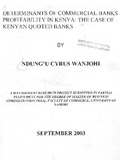| dc.description.abstract | This research is an attempt to identify determinants of profitability of commercial banks as a
step towards providing practical guide towards improved profitability. A study in Malaysia
by Guru, (1999), raised questions, which are relevant to this study:
• Why are some commercial banks more successful than others?
• To what extent, are the performance disparities due to variations In management
controllable internal factors and to what extent; do environment related external factors
influence the performance of these institutions?
This study was based on a sample of seven local Kenyan commercial banks quoted on the
Nairobi Stock Exchange (NSE). The period of study spans over ten years from 1993 to 2002.
The profitability determinants were basically divided into two main categories, namely the
internal determinants and the external determinants. The internal determinants included
management controllable factors such as liquidity, capital adequacy, asset and liability
portfolio management and expenses management. On the other hand, the external
determinants included those factors, which are beyond the control of the management of these
institutions such as ownership, firm size and external economic conditions such as inflation
rates, market interest rate, regulatory conditions and market growth. Regression analysis was
applied to a linear model to analyze the profitability determinants of the Kenyan commercial -. banks. The research methodology was adopted from a study conducted in Malaysia by Guru
(1999).
The findings of this study revealed that sound asset and liability management was found to
have a significant influence on profitability. Among the external factors, high market interest
rate was found to have an adverse effect on commercial bank profitability in Kenya. On the
other hand, market share was found to have a positive impact on profitability.
The above findings provide an insight into the characteristics and practices of the successful
commercial banks in terms of profitability. In view of these findings, conclusions can be made
which may be useful to bank management policy makers and shareholders. Since there is no
consensus on the financial factors that contribute to the bank profitability, it can be concluded
that individual bank managers use different strategies to achieve their profitability objectives.
Commercial banks should be prudent in providing credit for the financing of investments in
highly volatile sectors such as the stock market and the property market. In this context,
lending to the productive sectors with proper monitoring systems and sound credit
management is recommended. In the case of investments in subsidiaries, the commercial
banks must ensure that they have the knowledge and management expertise to properly
supervise and manage the acquired businesses so that they do not affect the profitability of the
acquiring bank. | en |

